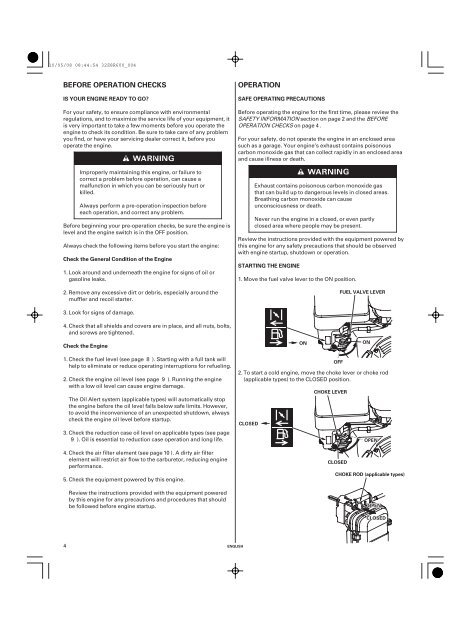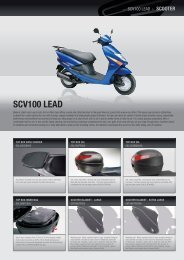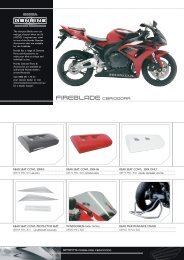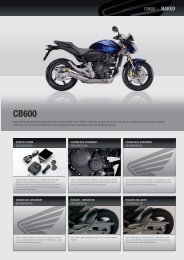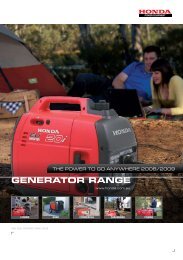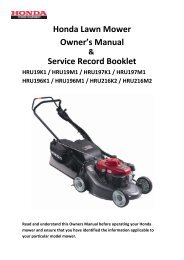GX240 · GX270 · GX340 · GX390 - Honda Motorcycles
GX240 · GX270 · GX340 · GX390 - Honda Motorcycles
GX240 · GX270 · GX340 · GX390 - Honda Motorcycles
You also want an ePaper? Increase the reach of your titles
YUMPU automatically turns print PDFs into web optimized ePapers that Google loves.
10/05/08 08:44:54 32Z8R600_004<br />
BEFORE OPERATION CHECKS<br />
IS YOUR ENGINE READY TO GO?<br />
For your safety, to ensure compliance with environmental<br />
regulations, and to maximize the service life of your equipment, it<br />
is very important to take a few moments before you operate the<br />
engine to check its condition. Be sure to take care of any problem<br />
you find, or have your servicing dealer correct it, before you<br />
operate the engine.<br />
Check the General Condition of the Engine<br />
Check the Engine<br />
3. Check the reduction case oil level on applicable types (see page<br />
9 ). Oil is essential to reduction case operation and long life.<br />
4. Check the air filter element (see page 10 ). A dirty air filter<br />
element will restrict air flow to the carburetor, reducing engine<br />
performance.<br />
5. Check the equipment powered by this engine.<br />
4<br />
Improperly maintaining this engine, or failure to<br />
correct a problem before operation, can cause a<br />
malfunction in which you can be seriously hurt or<br />
killed.<br />
Always perform a pre-operation inspection before<br />
each operation, and correct any problem.<br />
Before beginning your pre-operation checks, be sure the engine is<br />
level and the engine switch is in the OFF position.<br />
Always check the following items before you start the engine:<br />
1. Look around and underneath the engine for signs of oil or<br />
gasoline leaks.<br />
2. Remove any excessive dirt or debris, especially around the<br />
muffler and recoil starter.<br />
3. Look for signs of damage.<br />
4. Check that all shields and covers are in place, and all nuts, bolts,<br />
and screws are tightened.<br />
1. Check the fuel level (see page 8 ). Starting with a full tank will<br />
help to eliminate or reduce operating interruptions for refueling.<br />
2. Check the engine oil level (see page 9 ). Running the engine<br />
with a low oil level can cause engine damage.<br />
The Oil Alert system (applicable types) will automatically stop<br />
the engine before the oil level falls below safe limits. However,<br />
to avoid the inconvenience of an unexpected shutdown, always<br />
check the engine oil level before startup.<br />
Review the instructions provided with the equipment powered<br />
by this engine for any precautions and procedures that should<br />
be followed before engine startup.<br />
ENGLISH<br />
OPERATION<br />
SAFE OPERATING PRECAUTIONS<br />
Before operating the engine for the first time, please review the<br />
SAFETY INFORMATION section on page 2 and the BEFORE<br />
OPERATION CHECKS on page 4 .<br />
For your safety, do not operate the engine in an enclosed area<br />
such as a garage. Your engine’s exhaust contains poisonous<br />
carbon monoxide gas that can collect rapidly in an enclosed area<br />
and cause illness or death.<br />
STARTING THE ENGINE<br />
CLOSED<br />
Exhaust contains poisonous carbon monoxide gas<br />
that can build up to dangerous levels in closed areas.<br />
Breathing carbon monoxide can cause<br />
unconsciousness or death.<br />
Never run the engine in a closed, or even partly<br />
closed area where people may be present.<br />
Review the instructions provided with the equipment powered by<br />
this engine for any safety precautions that should be observed<br />
with engine startup, shutdown or operation.<br />
1. Move the fuel valve lever to the ON position.<br />
ON<br />
OFF<br />
CHOKE LEVER<br />
CLOSED<br />
FUEL VALVE LEVER<br />
2. To start a cold engine, move the choke lever or choke rod<br />
(applicable types) to the CLOSED position.<br />
ON<br />
OPEN<br />
CHOKE ROD (applicable types)<br />
OPEN<br />
CLOSED


